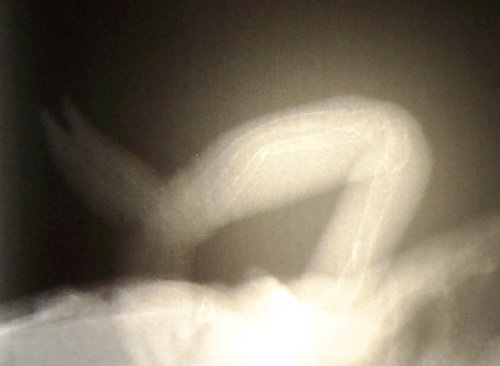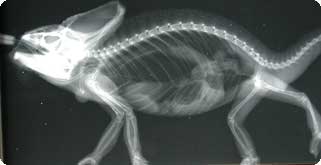KShook
Avid Member
Hello Everyone,
As some of you already know..I've aquired a new Female Ambilobe from a friend of mine who did not know how to properly care for chameleon and there well being..anyways I work for a Vet Office and I told him I'll bring her in if he pays for everything...Of course this was "Declined" Now that he does not want her I'm bringing her in on friday "Tomorrow" I've done so much reseach on her symptoms..which is falling off her branches and very weak. But on theup side she still eats and drinks REALLY well. Anyways..What I've come up with is MBD her limbs are not YET swollen...but maybe a slight case of MBD I found some really awesome X-Rays to show what it does to the chameleons..I think eveyone will find this REALLY interesting...Hope this helps those of you who dont know what this does..And if you have any other advise please throw it my way! Okay here's the X-Rays & Article:
The chameleon that came in egg-bound (see article 5th March) was found to be deficient in calcium. This is a fairly common problem in captive chameleons and it can be quite difficult to ensure the correct ratios of calcium, phosphorous, vitamin D and UV light. These factors can all play a role in the amount of calcium a chameleon takes in and then absorbs in a way that it can use effectively. The end result of a deficiency is that bones do not grow correctly (often curved instead of straight) and eggs cannot form the correct shell structure and then cannot be laid.
The xray below shows the very thin cortex (outer part of the bones) and how the bones have curved in this chameleon.
Also...Here's how to PREVENT this: The only way to prevent MBD is to ensure your chameleon gets BOTH Calcium and UVA/UVB lighting "at least 12 hours a day". In order for the intestinal tract to absorb the calcium, it requires activated Vitamin D3 to be present. Vitamin D needs to be exposed to UV radiation "LIGHT" in order to become activated. This is why it's so curial to have full spectrum UV light in your reptiles environment!
As some of you already know..I've aquired a new Female Ambilobe from a friend of mine who did not know how to properly care for chameleon and there well being..anyways I work for a Vet Office and I told him I'll bring her in if he pays for everything...Of course this was "Declined" Now that he does not want her I'm bringing her in on friday "Tomorrow" I've done so much reseach on her symptoms..which is falling off her branches and very weak. But on theup side she still eats and drinks REALLY well. Anyways..What I've come up with is MBD her limbs are not YET swollen...but maybe a slight case of MBD I found some really awesome X-Rays to show what it does to the chameleons..I think eveyone will find this REALLY interesting...Hope this helps those of you who dont know what this does..And if you have any other advise please throw it my way! Okay here's the X-Rays & Article:
The chameleon that came in egg-bound (see article 5th March) was found to be deficient in calcium. This is a fairly common problem in captive chameleons and it can be quite difficult to ensure the correct ratios of calcium, phosphorous, vitamin D and UV light. These factors can all play a role in the amount of calcium a chameleon takes in and then absorbs in a way that it can use effectively. The end result of a deficiency is that bones do not grow correctly (often curved instead of straight) and eggs cannot form the correct shell structure and then cannot be laid.
The xray below shows the very thin cortex (outer part of the bones) and how the bones have curved in this chameleon.
Also...Here's how to PREVENT this: The only way to prevent MBD is to ensure your chameleon gets BOTH Calcium and UVA/UVB lighting "at least 12 hours a day". In order for the intestinal tract to absorb the calcium, it requires activated Vitamin D3 to be present. Vitamin D needs to be exposed to UV radiation "LIGHT" in order to become activated. This is why it's so curial to have full spectrum UV light in your reptiles environment!
Attachments
Last edited:







